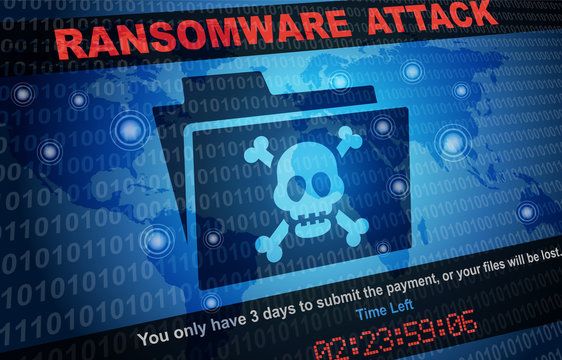
Ransomware, or ransom software, represents one of the most formidable threats in the field of cybersecurity. According to Cybersecurity Ventures and the European Union Agency for Cybersecurity (ENISA), ransomware attacks have seen an alarming surge in recent years. In 2023, it was estimated that ransomware attacks cost approximately $20 billion worldwide, and this figure is expected to reach $265 billion by 2031, according to a study by Cybersecurity Ventures. Additionally, a survey conducted by Bitdefender reveals that a company falls victim to a ransomware attack every 11 seconds, and nearly 50% of companies that pay the ransom do not recover all their data. In the face of such a significant rise, it is crucial for individuals and organizations to understand how these attacks work, how to protect themselves effectively, and what steps to take if an infection occurs. This article provides a comprehensive overview of ransomware.
I - What is ransomware?
A ransomware is a type of malicious software that encrypts a user’s files or blocks access to a system until a ransom is paid; in other words, it takes the files on your computer hostage. It can infect a computer, server, or even an entire network.
Once activated, the ransomware renders the files inaccessible and displays a ransom demand message. Initially appearing in Russia, ransomware has spread to systems worldwide, particularly in the United States, Australia, and Germany.
Often, ransomware infiltrates systems in the form of a computer worm or malware through a downloaded file or an email attachment, then encrypts the victim’s data and files with the goal of extorting money.
Ransom payments are frequently demanded in virtual currencies (such as bitcoin) to avoid leaving any trace. Ransomware, also known as ransom malware, is currently one of the major threats facing all computer systems connected to the web.
II - How do ransomware attacks work?
A ransomware attack is a multi-step process that ranges from initial access to the demand for ransom payment. Here are some of the key steps:
1. Propagation: Ransomware can spread in various ways. Common methods include phishing emails, which are fraudulent techniques designed to deceive users into providing personal or financial information by posing as a trusted entity. It can also spread through infected websites or software vulnerabilities. Attackers may use social media or malicious attachments to distribute the ransomware.
2. Infection: Once a user clicks on a link or opens an infected file, the ransomware begins its encryption process. It scans files on the hard drive and sometimes on connected devices or networks, encrypting these files with robust encryption algorithms.
3. Ransom Demand: After encryption, the ransomware displays a ransom message to the user, usually demanding a sum of money in cryptocurrency like Bitcoin to decrypt the files. This message may also include threats to delete the files if the ransom is not paid within a specified timeframe.
4. Decryption: If the ransom is paid, the attackers may send a decryption key. However, there is no guarantee that files will be recovered, and paying the ransom encourages cybercriminals to continue their activities.
III – Types of ransomware
Crypto-ransomware: Often simply referred to as ransomware, this type of malicious software is designed to encrypt files on the victim’s computer, making them inaccessible until a ransom is paid. This type of ransomware is particularly harmful because it not only locks access to data but also demands payment to unlock it. Examples include WannaCry and CryptoLocker.
Locker ransomware: This is a sub-type of ransomware that blocks access to a computer or device by completely restricting the use of the system or preventing access to essential files. Unlike crypto-ransomware, which encrypts files to make them inaccessible, locker ransomware focuses on locking the system or device itself, often by altering system settings or displaying a lock screen. Examples include Police ransomware.
Doxware (or extortionware): Also known as disclosure ransomware or information disclosure ransomware, this type of ransomware threatens to publish or disclose sensitive or compromising information about a victim, usually to extort money. Unlike traditional ransomware that encrypts files to make them inaccessible, doxware focuses on the threat of making private data public, which can have severe repercussions for the victim’s reputation. Examples include Dox ransomware.
IV -How to Protect Yourself Against Ransomware?
Regular Backups: Regularly back up your important files and store them on an external drive or in the cloud. Ensure that backups are not accessible from the main network to prevent them from being encrypted as well.
Keep Software Updated: Keep your operating systems and software up to date with the latest security patches. Updates fix vulnerabilities that ransomware can exploit.
Use Antivirus and Anti-Malware Protection: Use reputable antivirus and anti-malware software and keep it updated. These tools can detect and block ransomware before it causes harm.
Be Cautious with Emails and Links: Be cautious when opening emails or clicking on links, especially if they come from unknown sources. Avoid downloading suspicious attachments or clicking on dubious links.
V - What to Do If You Are a Victim of Ransomware?
If you are a victim of a ransomware attack, your computer system is likely locked, and your data is probably encrypted. Since ransomware can spread via the cloud, internal networks, or the internet, you should:
1. Isolate the Infection: Immediately disconnect the infected computer from the network to prevent the ransomware from spreading to other systems.
2. Do Not Pay the Ransom: While it may seem like a quick solution, there is no guarantee that you will receive the decryption key. Additionally, paying encourages cybercriminals to continue their activities.
3. Report the Incident: Contact local authorities and report the incident. Many government agencies and cybersecurity organizations can provide advice and assistance. Examples include:
– The National Agency for the Security of Information Systems (ANSSI) in France
– The Federal Bureau of Investigation (FBI) in the USA
– The National Cyber Security Centre (NCSC) in the UK
– Europol in the European Union
– The General Directorate of Security (GDS) in Belgium
4. Consult Cybersecurity Experts: Engage cybersecurity professionals to assess the extent of the damage, attempt to recover files (if possible), and strengthen security measures to prevent future infections.
5. Restore Files: Use your backups to restore lost files. Ensure that the backups are free of malware before proceeding with the restoration.
Ransomware attacks have become one of the most formidable threats in the field of cybersecurity, demonstrating an alarming ability to disrupt critical systems, demand high ransoms, and cause significant financial and reputational damage. By encrypting data and threatening to disclose sensitive information, these malicious programs exploit vulnerabilities to extort money from victims, whether individuals or organizations.
In the face of this growing threat, it is essential to remain vigilant. Implementing preventive measures such as regular data backups, system updates, and using robust security software can help minimize the risks and impacts of ransomware. Additionally, raising awareness about security practices and cooperating with specialized agencies can provide valuable support in the event of an incident.
For more information, advice, and resources on cybersecurity, feel free to share this article with your contacts and check out our blog to stay informed about the latest news and strategies in digital security.
Sources :







